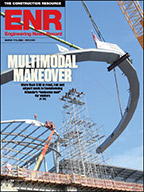Denver Airport Weighs Rail-Span Options
Officials with the Denver International Airport will decide this year whether to move ahead with a signature rail bridge design, unveiled July 29, by architect-structural engineer Santiago Calatrava. The 720-ft-long suspension bridge would likely have a $60-million-plus price tag, which is more than double preliminary cost estimates.

The symmetrical, tied-arch, steel-and-concrete span is planned as part of a $650-million south terminal redevelopment, which also includes a hotel and a train station. But it is also part of a commuter rail link owned by Denver’s Rapid Transportation District (RTD). The new airport-rail link in general will be financed, built, maintained and operated under a 46-year public-private partnership (P3) agreement. But if the airport decides to move forward with the signature bridge, it will be built under a separate construction management-general contractor contract with Edward Kraemer & Sons, Plain, Wis., according to Dave Rhodes, the airport’s deputy manager of engineering and planning.
Another possibility is that the airport would turn responsibility for building the bridge back to the concessionaire, a team led by Macquarie Group, Sydney, Australia, and Fluor Corp., Irving, Texas, Rhodes says. The P3 team’s design would be a standard concrete girder bridge.
Officials will have a better idea of how much funding the bridge would get from the concessionaire after the P3 team finalizes its funding, which is expected this month. Thanks to an interagency agreement, the airport could decide to take the P3 team’s design and improve upon it. “We would give those [improvements] to Calatrava and Parsons to work with,” says Rhodes. “We’re looking for a bridge that better meets the future needs of the airport and makes a greater statement than the basic standard design.”
Located about a mile-and-a-half from the airport, which is 25 miles from Denver proper, the Calatrava-designed bridge would feature a 620-ft-long main span with a box girder deck that hangs from a single arch by cables. The main span is flanked by orthotropic decks on steel ribs. The distance from the roadway to the top of the bridge is 144 ft. According to Calatrava’s engineer-son, Gabriel, the bridge’s deck, without train tracks, would most likely be manufactured off site and then “launched” into place, using temporary supports to limit traffic disruption on the street below. A crane would then lift the arch into place in sections and the cables would be attached.
Calatrava is a member of a team led by Parsons Transportation Group’s Denver office, which is the program manager for the overall redevelopment. The project, financed mostly by general airport revenue bonds, includes a canopy-covered train station otherwise open to the elements, and a 500-room hotel.
The bridge and hotel are expected to be completed by 2013. Completion of the train station is expected two years later. Commuter rail service is scheduled to begin in 2016.
At the unveiling of the rail bridge design, Santiago Calatrava said his biggest challenge was to design a hotel and train station complex that would complement the airport’s main terminal, which has a fabric roof featuring a series of peaks that reflect mountains nearby.
“It is always a problem to add to an existing building,” says Calatrava. “In this case, it is an outstanding building that has become an icon.”



